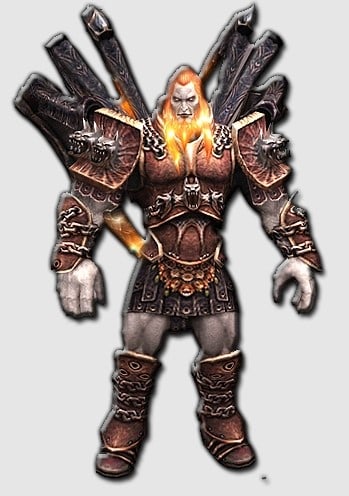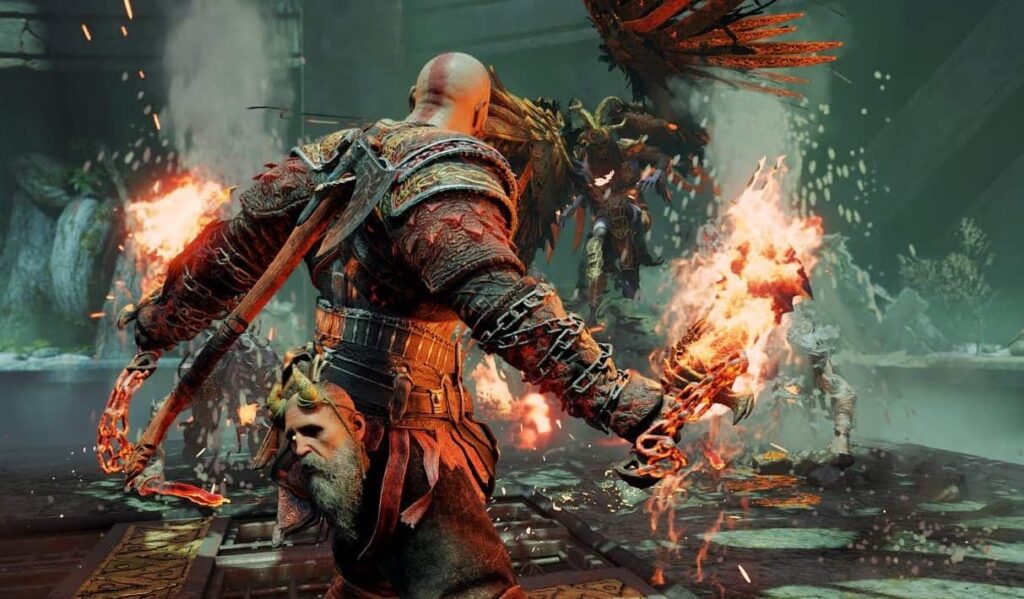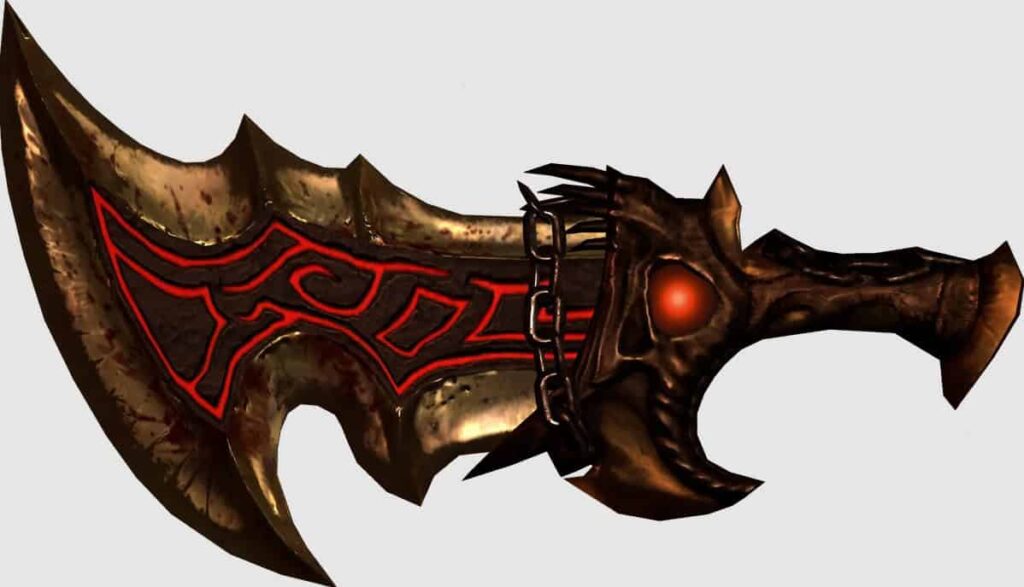What are the Blades of Chaos?
TLDR: The Blades of Chaos, forged by Ares and bound to Kratos, evolve throughout the God of War series, reflecting his tumultuous journey from vengeance to redemption while maintaining their formidable power across both Greek and Norse mythologies.
The Blades of Chaos are more than just weapons; they’re the beating heart of the God of War series. From the moment I first saw Kratos whip those fiery chains across the screen, I knew I was witnessing something special. These blades aren’t just tools of destruction; they’re a character in their own right, with a history as rich and complex as Kratos himself. Created by Ares and bound to our anti-hero’s arms, the Blades of Chaos represent both the curse of Kratos’ past and the potential for his redemption. In my opinion, no other weapon in gaming history has managed to capture the essence of its wielder quite like these iconic blades.
The Origins of the Blades of Chaos
The origins of the Blades of Chaos are deeply rooted in the lore of the God of War series, intertwining Greek mythology with the game’s unique narrative. These iconic weapons were forged by Ares, the Greek God of War, in the darkest depths of the Underworld. Ares, known for his brutal and cunning nature, created these blades as a symbol of servitude and a conduit for his power.
The purpose behind the forging of the Blades of Chaos was multifaceted. Primarily, Ares intended them to be wielded by a mortal champion who would serve as his earthly agent. These blades were not merely weapons but also a means of control, binding the wielder to Ares’ will. The God of War sought a warrior who could carry out his bidding on the mortal plane, spreading chaos and destruction in his name. By creating these blades, Ares ensured that his chosen champion would have the power to fulfill this role effectively.
Perhaps the most intriguing aspect of the Blades of Chaos is their connection to primordial fire or chaos. According to the lore, these blades were imbued with the essence of primordial fire, a fundamental force of creation in the God of War universe. This connection to primordial elements gives the blades their extraordinary power and their ability to ignite with each strike. The primordial fire within the blades is not just a source of destructive power but also a link to the very foundations of the cosmos.
The connection to chaos is equally significant. In God of War mythology, chaos is often portrayed as a primordial state of existence, predating the ordered universe. By incorporating this chaotic essence into the blades, Ares created weapons that could potentially disrupt the natural order, aligning perfectly with his role as a god of war and destruction.
Key aspects of the Blades of Chaos’ origins include:
- Forged by Ares in the Underworld
- Designed for a mortal champion
- Imbued with primordial fire
- Connected to the concept of chaos
Physical Characteristics of the Blades of Chaos
In appearance, the Blades of Chaos are formidable short swords, each approximately 24 inches in length from pommel to tip. The blades themselves are curved and feature a distinctive, jagged edge designed for maximum carnage. The most striking visual element is their ability to ignite, wreathing the blades in otherworldly flames during combat.
The materials used in the construction of the Blades of Chaos are not of mortal origin. Forged in the depths of Hades, these weapons are said to be crafted from an amalgamation of metals and magical essences. The blades themselves are made from an indestructible metal, likely imbued with the essence of primordial fire or chaos. This unique composition grants them their unbreakable nature and ability to channel elemental energies.
The unique design elements of the Blades of Chaos set them apart from any conventional weapon:
- Chains: Permanently affixed to the wielder’s forearms
- Blades: Curved with jagged edges, capable of igniting
- Handles: Intricately designed with demonic motifs
- Pommels: Shaped to resemble demonic skulls
Perhaps the most distinctive feature of the Blades of Chaos is the chain mechanism. These chains, forged from the same indestructible material as the blades, are magically bound to the wielder’s forearms. This design allows for unprecedented range and versatility in combat, enabling the user to swing the blades in wide arcs or propel them at distant enemies.
The handles of the Blades of Chaos are a work of art in themselves. Intricately designed with demonic motifs, they often feature skeletal or monstrous faces worked into the metal. The pommels are typically shaped to resemble snarling demonic skulls, adding to the weapons’ fearsome appearance.
The Magical Properties of the Blades of Chaos
One of the most notable enchantments of the Blades of Chaos is their ability to ignite with otherworldly flames. This fire is not mere mortal flame, but rather a manifestation of primordial fire, the same elemental force that is said to have birthed the cosmos. This connection to primordial fire grants the blades immense destructive potential and allows them to overcome supernatural obstacles. For instance, in God of War (2018), the Blades of Chaos were able to ignite in the frigid realm of Helheim, where no other fire could burn.
The Blades of Chaos demonstrate an impressive ability to channel various elemental forces beyond just fire. Throughout the God of War series, Kratos has been able to imbue the blades with different elemental properties, enhancing their effectiveness against specific types of enemies or obstacles. This adaptability showcases the blades’ connection to fundamental cosmic forces and their ability to harness them in combat.
Perhaps the most intriguing magical property of the Blades of Chaos is their deep connection to Kratos’ rage and power. The weapons seem to respond to and amplify Kratos’ emotional state, particularly his anger. This symbiotic relationship between wielder and weapon is evident in how the blades’ flames intensify as Kratos’ rage builds during combat. It’s theorized that this connection stems from the blades being forged with not just primordial fire, but also primordial chaos, which may resonate with the chaotic nature of Kratos’ own fury.
Key magical properties of the Blades of Chaos include:
- Ability to ignite with primordial fire
- Power to channel various elemental forces
- Capacity to amplify and respond to Kratos’ rage
- Indestructibility and self-regeneration
The Blades of Chaos in Kratos’ Journey
The Blades of Chaos were first bestowed upon Kratos by Ares, the Greek God of War, as a symbol of Kratos’ servitude. This occurred when Kratos, facing certain death in battle, pledged his life to Ares in exchange for victory. The blades became an extension of Ares’ will, allowing him to exert control over Kratos and channel his destructive power. During this period, Kratos used the blades to carry out Ares’ bidding, spreading chaos and destruction across ancient Greece.
The binding of the Blades of Chaos to Kratos was a brutal and symbolic act. Ares magically grafted the chains of the blades to Kratos’ forearms, scarring him both physically and mentally. This permanent attachment served as a constant reminder of Kratos’ oath and the price of his allegiance to Ares. The process was excruciatingly painful, further cementing Kratos’ transformation into the “Ghost of Sparta.”
Throughout Kratos’ journey, the Blades of Chaos have been involved in numerous notable battles and events. Some of the most significant include:
- The massacre at the village of Athena’s followers
- The battle against the Hydra
- Kratos’ confrontation with Ares
- The defeat of Zeus and the fall of Olympus
- The journey through Helheim in the Norse realm
The Curse of the Blades of Chaos
The nature of the curse is multifaceted. Primarily, it ensures that the Blades of Chaos are permanently bound to Kratos. This binding is not merely physical; the blades have an uncanny ability to return to Kratos even when he tries to discard them. The curse also seems to have imbued the blades with a form of sentience, allowing them to influence Kratos’ emotional state, particularly his rage. This aspect of the curse ties into the primordial chaos and fire that were used in the blades’ creation, suggesting a deep connection to fundamental forces of the universe.
The effects of this curse on Kratos are severe and far-reaching. The most immediate impact is the constant physical pain caused by the chains seared into his flesh. These wounds never fully heal, serving as a perpetual reminder of his past sins. Psychologically, the curse amplifies Kratos’ rage and violent tendencies. It’s suggested that the blades feed on and fuel his anger, creating a vicious cycle of violence and regret. This influence has led Kratos to commit numerous atrocities, including the accidental slaughter of his own family while under Ares’ control.
Kratos has made several attempts to rid himself of the Blades of Chaos, each highlighting the strength of the curse:
- Physical abandonment: Kratos has tried to discard the blades, only for them to mysteriously reappear.
- Emotional rejection: He’s attempted to distance himself emotionally from the blades, but their influence persists.
- Replacement: Kratos has used other weapons, like the Leviathan Axe, in an attempt to move on from the blades.
- Spiritual cleansing: He’s sought redemption and peace, hoping to break the blades’ hold on his soul.
Evolution of the Blades of Chaos
In the original God of War, the Blades of Chaos were presented as curved short swords with intricate designs etched into their surface. They emitted a fiery orange glow when in use, symbolizing their connection to the fires of Hades. As Kratos progressed through the game, the blades’ power increased, manifesting as more intense flames and increased damage output.
Following Kratos’ ascension to godhood at the end of the first game, the Blades of Chaos transformed into the Blades of Athena. This change marked a significant shift in Kratos’ allegiance and the source of his power. The Blades of Athena retained a similar shape but featured a more refined, golden appearance, reflecting Athena’s divine influence. They emitted a bluish-white glow, contrasting with the fiery orange of their predecessors.
In God of War III, after Kratos’ fall into the River Styx, the damaged Blades of Athena were reforged by Athena into the Blades of Exile. These new weapons featured a more rugged, battle-worn appearance, with jagged edges and a design that seemed to incorporate elements of both Greek and primordial aesthetics. The Blades of Exile glowed with a fierce red energy, perhaps symbolizing Kratos’ renewed rage and his exile from Olympus.
The most recent iteration of the blades, seen in God of War (2018) and Ragnarök, represents a return to their original form as the Blades of Chaos. However, their appearance has been updated to reflect the Norse setting. The blades now feature more angular, almost rune-like patterns, and their glow has become more subdued, often appearing as smoldering embers rather than open flames.
Throughout these transformations, the core functionality of the blades remained consistent:
- Chained to Kratos’ arms
- Ability to be thrown and recalled
- Imbued with elemental powers (primarily fire)
- Capable of executing devastating combo attacks
To illustrate the evolution of the blades across the main series entries, consider this table:
| Game | Weapon Name | Appearance | Notable Power/Feature |
| God of War (2005) | Blades of Chaos | Curved, fiery orange glow | Fire-based attacks |
| God of War II | Blades of Athena | Golden, bluish-white glow | Divine energy attacks |
| God of War III | Blades of Exile | Rugged, fierce red energy | Enhanced combo potential |
| God of War (2018) | Blades of Chaos (Norse) | Angular patterns, ember-like glow | Adaptability to Norse magic |
Despite the changes in appearance and nomenclature, the enduring nature of these blades is evident in their consistent presence throughout Kratos’ journey across different pantheons. Their ability to adapt to new mythological contexts while retaining their core essence speaks to their deep connection with Kratos himself.
In the transition from Greek to Norse mythology, the Blades of Chaos demonstrated remarkable versatility. They retained their fire-based powers but also showed the capacity to interact with Norse magical concepts, such as the ability to clear Hel-bramble in Helheim. This adaptability suggests that the blades’ power may be more primordial in nature, transcending the boundaries of specific mythological systems.
The Blades of Chaos and Kratos’ Character Development
Initially, the Blades of Chaos represented Kratos’ enslavement to Ares and his violent past. They were a constant reminder of the atrocities he committed, including the accidental slaughter of his own family. The blades’ ability to ignite with otherworldly flames mirrored Kratos’ burning rage and desire for vengeance. As Kratos grappled with his guilt and anger, the blades remained a tangible link to his troubled history.
In God of War (2018), Kratos’ relationship with the Blades of Chaos takes on new significance in his quest for redemption. Despite his attempts to leave his past behind, Kratos is forced to retrieve the blades to save his son Atreus. This moment marks a turning point in Kratos’ character development, as he confronts his past not out of a desire for vengeance, but out of love for his son. The act of reclaiming the blades symbolizes Kratos’ acceptance of his history and his determination to use his power for protection rather than destruction.
The symbolism of using the Blades of Chaos for good in later games is particularly poignant. In God of War (2018) and Ragnarök, Kratos wields the blades not as tools of indiscriminate violence, but as a means to protect his family and allies. This shift in purpose reflects Kratos’ personal growth and his evolving understanding of power and responsibility. The blades, once symbols of his enslavement to rage, become instruments of his redemption.
Key aspects of the Blades of Chaos in Kratos’ character development include:
- Representation of his violent past and inner turmoil
- Catalyst for confronting and accepting his history
- Symbol of his transition from vengeance to protection
- Tool for redemption through positive actions
The Blades of Chaos have become inextricably linked to Kratos’ journey of self-discovery and redemption. As Kratos learns to channel his rage into protecting those he loves, the blades transform from a burden of his past into a tool for forging a better future. This evolution mirrors Kratos’ own growth from a one-dimensional character driven by revenge to a complex, nuanced individual struggling with the weight of his past while striving to be a better father and person.
In the later games, Kratos’ reluctance to use the blades, followed by his decision to wield them for a noble purpose, symbolizes his ongoing struggle with his identity and his determination to change. The fact that he can now use these weapons, once associated with so much pain and destruction, to protect and nurture demonstrates the depth of his character development.
The Blades of Chaos in Different Realms
In Greek mythology, the Blades of Chaos were formidable weapons, perfectly suited to the chaotic and often violent world of the Greek gods. Their effectiveness was evident in Kratos’ ability to defeat numerous mythical creatures, demigods, and even gods themselves. The blades’ connection to the fires of Hades made them particularly potent against Greek mythological beings, as they channeled the very essence of the Greek underworld.
The adaptation of the Blades of Chaos to Norse mythology in later games is a testament to their versatility. When Kratos journeys to the Norse realms in God of War (2018), the blades retain their core abilities while also demonstrating new powers suited to this different mythological context. For instance, they prove effective against the icy denizens of Helheim, where other weapons fail. This adaptability suggests that the blades’ power transcends the boundaries of specific pantheons.
The explanation for the Blades of Chaos’ continued power across pantheons lies in their connection to primordial forces. As revealed in God of War Ragnarök, the blades are imbued with primordial fire, a fundamental element that predates and transcends individual mythological systems. This primordial essence allows the blades to maintain their potency regardless of the mythological context, as they draw upon forces that are universal and eternal.
Key aspects of the Blades of Chaos’ effectiveness across realms include:
- Connection to primordial fire
- Ability to adapt to different mythological contexts
- Effectiveness against a wide range of supernatural beings
- Capacity to channel elemental powers suited to each realm
To illustrate the Blades of Chaos’ adaptability across different mythological settings, consider this comparison table:
| Aspect | Greek Mythology | Norse Mythology |
| Primary Element | Fires of Hades | Primordial Fire |
| Notable Enemies | Greek Gods, Titans | Frost Giants, Draugr |
| Unique Ability | Soul-capturing | Hel-bramble clearing |
| Symbolic Meaning | Kratos’ enslavement | Kratos’ past and redemption |
The Blades of Chaos’ effectiveness in both Greek and Norse mythologies underscores their unique status as weapons that transcend pantheon-specific limitations. In the Greek setting, they were instruments of vengeance and destruction, perfectly aligned with Kratos’ role as the violent Ghost of Sparta. In the Norse realms, while retaining their destructive capabilities, they also become tools of protection and even redemption, mirroring Kratos’ own character development.
Craftsmanship of the Blades of Chaos
The unique forging techniques employed in creating the Blades of Chaos involve a combination of physical craftsmanship and divine enchantment. Ares forged these blades in the depths of Hades, utilizing the fires of the underworld to shape their form. The process likely involved infusing the metal with the essence of primordial chaos and fire, giving the blades their distinctive ability to ignite and channel elemental energies. This infusion of primordial forces is what allows the Blades of Chaos to maintain their power across different mythological pantheons.
When compared to other godly weapons in the series, the Blades of Chaos stand out for their versatility and enduring nature. Unlike weapons such as the Blade of Olympus or the Leviathan Axe, which are tied to specific gods or realms, the Blades of Chaos demonstrate an ability to adapt to different mythological contexts. This adaptability is likely due to their connection to primordial forces that predate individual pantheons.
The durability and maintenance of the Blades of Chaos are extraordinary. These weapons have withstood countless battles against gods, monsters, and even the ravages of time itself. Their ability to self-repair and regenerate is a key aspect of their magical nature. Unlike mortal weapons that require constant upkeep, the Blades of Chaos seem to maintain their edge and power through their inherent magical properties.
Key aspects of the Blades of Chaos’ craftsmanship include:
- Forged in the fires of Hades
- Infused with primordial chaos and fire
- Self-repairing and regenerating capabilities
- Ability to channel and adapt to different elemental energies
Where Can I Get a Replica of the Blades of Chaos?
If you’re looking to own a replica of the iconic Blades of Chaos, you’re in for a treat! These stunning collectibles are available through various online retailers, gaming merchandise stores, and specialty weapon shops. Whether you want a display piece for your collection or a detailed replica to show off your love for God of War, you’ll find options ranging from budget-friendly designs to high-quality, intricately crafted versions. Bring a piece of Kratos’s legendary journey into your home today!
Epic Swords

VikingVictory
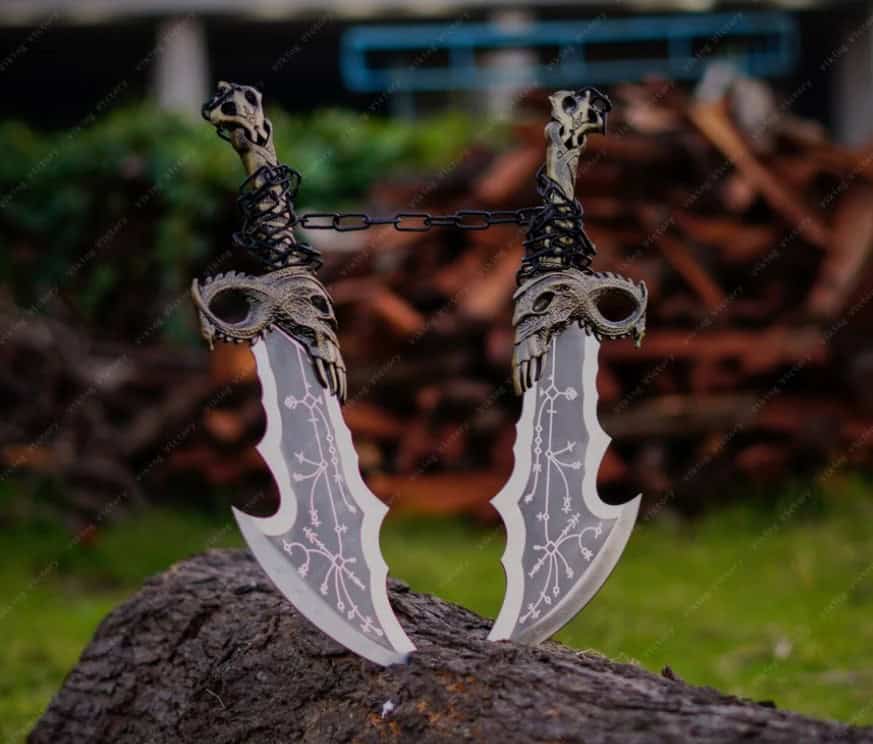
UmarsArtwork

VikingsCraftPk

GSPROPS
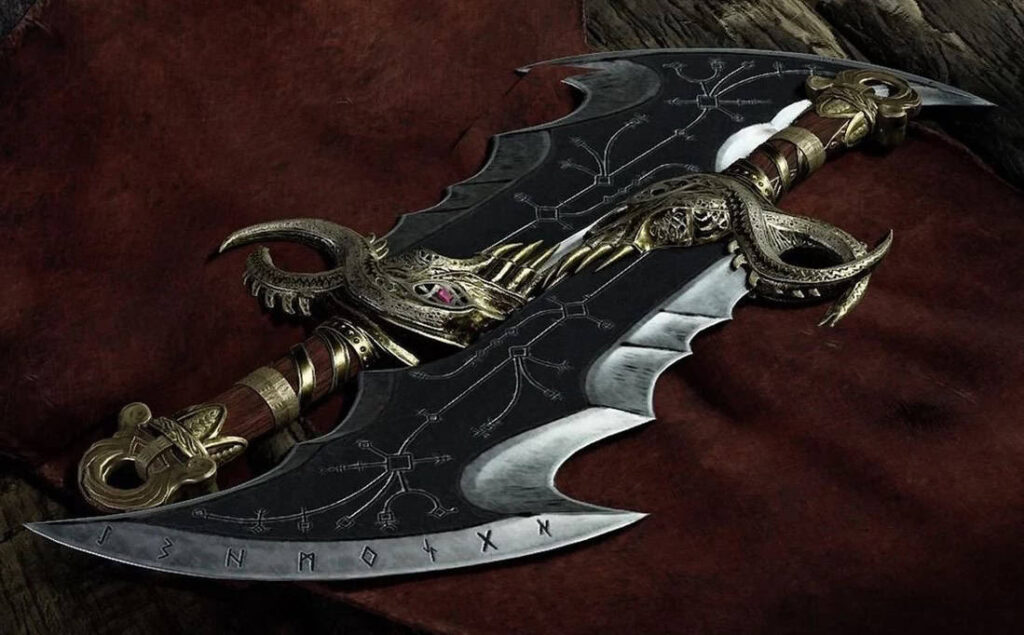
Final Thoughts
Reflecting on the journey of the Blades of Chaos, it’s evident that these weapons are more than just tools of destruction—they’re symbols of Kratos’s evolution. As they’ve adapted to new mythologies and mirrored his personal growth, these iconic blades have cemented their place in gaming history. Every time those chains ignite, the weight of their history and emotional significance is impossible to ignore. From battling Greek monsters to taking down Norse gods, the Blades of Chaos have stood out as some of the most legendary weapons in fantasy gaming, showcasing raw power, deep lore, and an incredible capacity for change.

